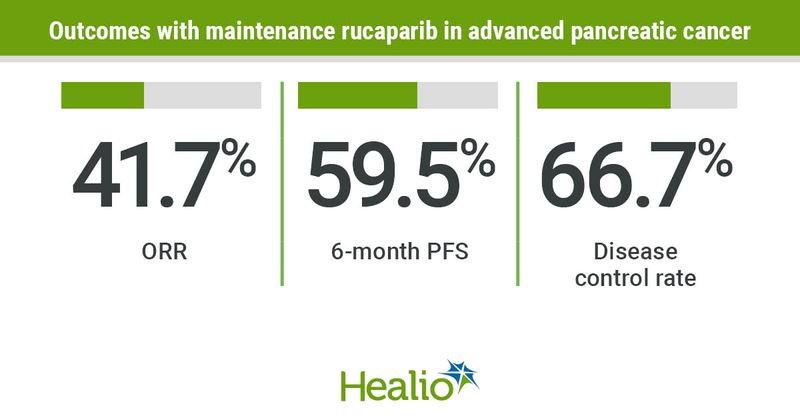Maintenance rucaparib shows benefit in broader group of patients with pancreatic cancer
Maintenance rucaparib appeared safe and effective for patients with platinum-sensitive advanced pancreatic cancer with pathogenic variants in BRCA1, BRCA2 or PALB2, according to research published in Journal of Clinical Oncology.
“The study expands upon the previously published POLO trial in that we saw benefit in patients with locally advanced disease, those with somatic variants, those with PALB2 variants and histologies beyond adenocarcinoma. Therefore, we have expanded the group of patients for whom maintenance PARP [poly(ADP-ribose) polymerase] inhibitors might be used,” Kim A. Reiss, MD, assistant program director of the hematology/oncology fellowship program and assistant professor of medicine at Hospital of the University of Pennsylvania, and a HemOnc Today Next Gen Innovator, told Healio.

Reiss and colleagues conducted the open-label, single-arm, single-stage, phase 2 study because they felt a broader group of patients with pancreatic cancer — in addition to those with germline BRCA variants — could benefit from maintenance therapy with PARP inhibitors such as rucaparib (Rubraca, Clovis Oncology), and that an enhanced understanding of the predictors of response to such treatment would help oncologists select patients most likely to benefit.

The efficacy analysis included 42 patients (median age, 61.5 years; range 35-81; 57% women) with advanced pancreatic cancer and a germline variant in BRCA1 (n = 7), BRCA2 (n = 27) or PALB2 (n = 6) or a somatic variant in BRCA2 (n = 2). Most of the patients, enrolled and treated at Abramson Cancer Center at University of Pennsylvania from September 2007 through October 2019, received 16 or more weeks of platinum-based chemotherapy with no evidence of platinum resistance, whereas six received less than 16 weeks due to intolerance or allergy and two received none.
After discontinuation of chemotherapy, patients received 600 mg oral rucaparib twice daily on days 1 to 28 of each 28-day cycle until progression or unacceptable toxicity.
PFS at 6 months served as the study’s primary endpoint.
Secondary endpoints included overall response rate, disease control rate, duration of response, OS and safety.
Median potential PFS follow-up was 18 months, and median potential OS follow-up was 24 months.
Results showed a 6-month PFS rate of 59.5% (95% CI, 44.6-74.4).
“[Because] the lower bound of the 95% CI exceeded the null hypothesis rate of 44%, the study met its primary objective (P = .042, Z test),” the researchers wrote.
The 12-month PFS rate was 54.8% (95% CI, 39.7-69.9).
Median PFS was 13.1 months (95% CI, 4.4-21.8) and median OS was 23.5 months (95% CI, 20-27.
Researchers reported an ORR of 41.7% (95% CI, 25.5-59.2) among 36 patients with measurable disease, including three complete responses and 12 partial responses. Responders included 40.7% of patients (n = 11 of 27) with germline BRCA2,
50% of patients (n = 3 of 6) with germline PALB2 and 50% of patients (n = 1 of 2) with somatic BRCA2. None of the seven patients with germline BRCA1 mutation responded.
The disease control rate was 66.7% (95% CI, 49-81.4) and median duration of response was 17.3 months (95% CI, 8.8-25.8). Two of the three complete responders remained in remission more than a year later, according to researchers.
“It is quite striking that there are such broad differences in benefit to PARP inhibition even in such a small genomic group,” Reiss said. “It brings home the point, as the POLO study did, that genomic identification of a pathogenic variant is not the be-all-end-all biomarker of response in this patient population.”
Researchers noted no new safety signals. Among 46 patients evaluable for safety, the most common adverse events possibly related to rucaparib included anemia (74%), nausea (48%), increased alanine aminotransferase (47%), fatigue (45%), thrombocytopenia (39%) and dysgeusia (37%). Most events were grade 1 or grade 2 and no grade 4 treatment-related events occurred, researchers wrote.
The study was limited in that it was not a randomized, controlled trial and was performed at a single institution.
“This was a single-arm, single-institution study, and any clinical implications must be taken in that context,” Reiss said. “That said, we have shown benefit in patients with advanced pancreatic cancer beyond those with germline BRCA variants. We also observed benefit in patients who did not receive a full 4 months of platinum therapy prior to receiving rucaparib, which is important given that, for some patients, toxicities emerge before 4 months of therapy.”
In moving the research forward, Reiss said next steps will include identifying clinically usable assays or metrics to better predict who will benefit from this approach, meeting the need of establishing maintenance therapies in a broader group of patients, and identifying combinations that may be more effective and strategies to reverse PARP inhibitor resistance.
“Perpetual chemotherapy can degrade quality of life and cause organ dysfunction,” she said. “For this reason, studying lower-toxicity maintenance therapies is a critical step toward bettering the lives of our patients.”
For more information:
Kim A. Reiss, MD, can be reached at Perelman Center for Advanced Medicine, South Tower, 10th Floor, 3400 Civic Center Blvd., Philadelphia, PA 19106; email: kim.reissbinder@pennmedicine.upenn.edu.

